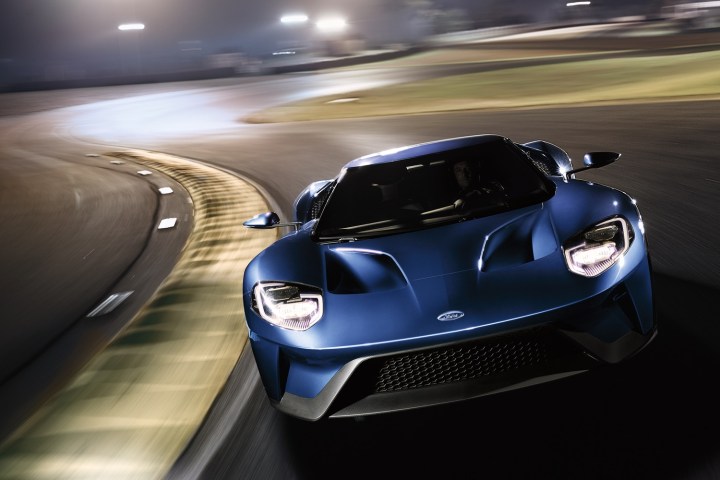
Normal and Wet modes are the most conservative and their names should be pretty self-explanatory. Both modes set the ride height to 120 millimeters, the suspension to its most compliant “comfort” setting, and keep electronic driver aids at their most-alert settings. The GT’s moveable rear wing is active in these modes, deploying automatically at 90 mph and acting as an air brake when necessary. Wet mode tweaks throttle calibration to limit the potential for slippage.
Sport mode loosens the GT’s leash. Crucially, it activates a race-car-style, anti-lag system, which keeps the 3.5-liter V6’s two turbos spooled up at all times to prevent turbo lag. The suspension also moves into a more aggressive setting and the driver can now adjust the traction and stability controls.
Track mode takes things in a more hardcore direction. Activating it requires putting the GT in Park so that it can rearrange itself. The ride height drops to 50 millimeters, the rear spoiler deploys from the get-go and aerodynamic openings in the front close. All of that happens in less than two seconds, according to Ford. The suspension also tenses up: The spring rates increase and the dampers go to their firmest setting. You wouldn’t want to encounter a pothole in that configuration, so this mode really is based saved for racetracks only.
Finally, V-Max mode is meant to allow the GT to achieve its top speed of 217 mph. Like Track mode, it requires putting the car into Park, in this case, so the rear spoiler and other aerodynamic elements can be stowed. The downforce these bits produce helps create grip but it also produces drag that slows the car down. Ride height is lowered to the same 50 mm as Track mode, but unlike that handling-focused mode, stability control is not adjustable.
In addition to the drive modes, the GT features another modern performance-car staple: Launch control. Like other systems, it enables a quick and clean launch so that the driver can impress his or her friends. Available in all driving modes except Wet, launch control simply requires depressing the brake pedal, building up revs with the throttle, and lifting off the brake when cued by a dashboard light. We’re itching for a chance to try it.
Editors' Recommendations
- Goliath car screens have arrived, and Ford’s new software takes full advantage
- Modern cars take touch controls too far. This company found a balance
- Watch Ford’s robot test drivers take a car for an on-the-spot spin
- 2022 Audi e-tron GT first drive review: This slot car needs no track
- 2021 Ford F-150 hybrid first drive review: Tech can be tough


